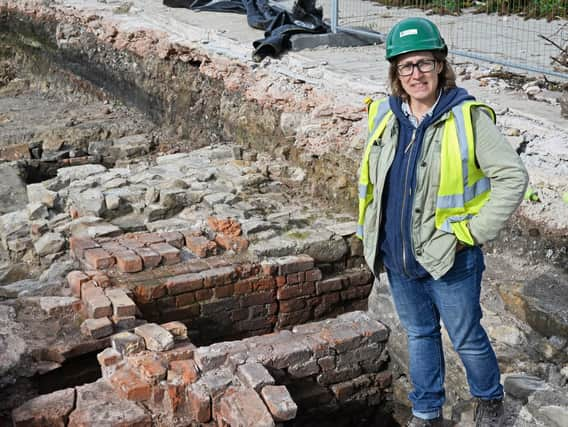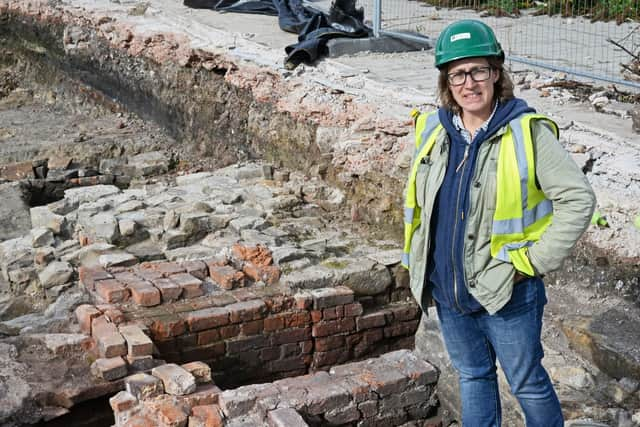Sheffield Castle dig finishes: '˜Best discovery' points to earlier Norman stronghold


A two-month excavation programme on the vast space cleared when the city centre's indoor market moved to The Moor has unearthed many finds '“ medieval pottery, tiles, and even an ancient '˜ear scoop' among them.
But principal archaeologist Dinah believes the plot is '“ locally at least '“ uniquely comprehensive for the way its early underground layers have been preserved.


Advertisement
Hide AdAdvertisement
Hide Ad'Very often when sites are developed, each time they get flattened and they lose part of the story,' she says.Â
This quality explains the survival of what is likely to be the project's most impressive discovery '“ traces of a Norman '˜motte', or raised earthwork, which may prove the existence of a second, earlier castle that would pre-date the stronghold known to have been demolished at the end of the Civil War over 300 years ago.
It means the plural must now be used when talking about this chapter of Sheffield's history, Dinah observes. 'We have to say '˜castles'.'Â
The dig was paid for through a £786,000 package of '˜kickstart funding' from Sheffield Council, which wants to revive the wider Castlegate area by making it more attractive, modern and vibrant, incorporating what is left of the city's medieval past, much of which was lost to industry in the 19th and 20th centuries.
Advertisement
Hide AdAdvertisement
Hide AdWessex Archaeology, one of the UK's leading practices, was hired to carry out the investigation, which had a simple objective, says Dinah, who is advising the council.
'The strategy has been to test the questions we had about the site by how little we thought we knew,' she explains. All 11 trenches have '˜thrown up interesting information', she says. ' Some of it is what we were expecting, some is not what we were expecting '“ but that is the nature of archaeology.'
The dig is now in its last week, and has attracted a huge amount of interest '“ 300 volunteers have got involved, hundreds of visitors have taken part in tours and the team has received more than 17,000 enquiries. A virtual reality model of the castle was unveiled by Sheffield University at the Millennium Gallery, and students from Hallam University have been creating street art on hoardings, inspired by the area's heritage.
Two trenches were dedicated to looking for the moat, while higher up researchers tried to track down the inner court of the castle, where Mary Queen of Scots was imprisoned for over a decade.
Advertisement
Hide AdAdvertisement
Hide AdThe castle, which gave its name to the former Castle Market, came under siege from 1,200 Parliamentary troops during the Civil War. Soldiers bombarded the thick stone walls with fire - a large gun, Queen Elizabeth's Pocket Pistol, eventually breached the walls and the defenders gave in.
The first pit '“ four metres deep and dug by hand '“ was close to previous excavations, and uncovered what is thought to be part of a cementation furnace, once used in steelmaking.Â
'In the 18th century there's a very nice bowling green here,' says Dinah. 'That's encouraging from the archaeological point of view. If this was the bowling green after the castle was demolished, and then it was the yard of the steelworks, then there's good potential for us to get down to the earlier levels, and that's what Wessex have done. What we're finding is deposits we're happy show medieval activity.'
In the days of the bowling green '“ around 100 years after the castle was knocked down '“ the area was residential, with '˜quite nice housing' looking over the River Sheaf. 'A little bit like Endcliffe Park,' Dinah says.
Advertisement
Hide AdAdvertisement
Hide AdTrench two, however, looks rather different, she continues. 'We've been puzzling over what we can see.'
The team first encountered material from the steelworks, before hitting a substance that looked like natural ground. But, when Wessex looked closely, '˜very small bits of charcoal' were spotted.
'We're wondering whether this could be the remains of an earlier feature, a motte '“ the very first castles are often a timber structure built on top of an earth mound,' says Dinah.Â
'It could be it's later and it's something we've not seen elsewhere on the site, but the dating is going to be crucial. If it is the motte, we're going to have to completely rethink our geography of the castle site.'
Advertisement
Hide AdAdvertisement
Hide AdIt would be a Norman precursor to the demolished stone-built castle. 'We have pondered over the years whether Sheffield's first castle had a motte, or whether it was just built on a natural high point. It's really significant, but the scientific dating is going to be crucial.'
'If this turns out to be what we hope it is, then this is the biggest find, the best of the discoveries,' says Milica Rajic, project manager for Wessex. 'Forget the medieval pottery, the ear scoops and any of that. This is the information.'
The next trench matches the theory. 'I think we're looking at the remains of that 13th century castle here,' Milica states.
Elsewhere, the team dug down six metres to reach the moat. Architectural stones have been recovered from the channel, as well as soil samples which will offer information about Sheffield's environmentÂ
Advertisement
Hide AdAdvertisement
Hide Ad'It remains a mystery as to why they felt they needed to dig a moat 15 feet away from the river,' says Simon Ogden, the council's Castlegate programme director.
A full report giving a detailed view of the site, and the finds, will be published next year alongside proposals for how the area will be reshaped.
Without such a document, Simon says, the council is '˜shooting in the dark'. A plan to put up a Great Pier overlooking the archaeologists at work did not come together in time, but the project's benefits have still been extensive. 'It's established what we suspected, that there is this huge latent interest in this part of the city.'
Among other schemes, the second phase of the Grey to Green initiative, which involves sprucing up streets with plants, grasses and flowers, is expected to begin in Castlegate in early 2019. Nearby, the future of the Old Town Hall is still under discussion, the former Co-op department store is becoming a '˜digital tech hub' with a quality food hall and the ambition to uncover the River Sheaf as part of a new park remains.
Advertisement
Hide AdAdvertisement
Hide Ad'The ambition is to bring the site back into use,' says Simon. 'How we do that is still something we are working through with our partners.'
Several months of off-site analysis of the various discoveries will now follow, equalling the effort put in on the ground.Â
'We're going to go back into our offices and labs and do this amount of work, if not even more,' says Milica. 'This is just the beginning.'
Martin Gorman, chair of the Friends of Sheffield Castle, says the group would '˜love to excavate the whole site.'
Advertisement
Hide AdAdvertisement
Hide Ad'That would be the dream, but we have to be realistic as well. It's been achievable on other sites in the country, but we have to recognise an income has to be generated from the site longer-term. As Simon said, we just want to work together to achieve a great outcome. This particular piece of work has led us to find the original castle, which we never anticipated. There hadn't been any evidence found of it. We're talking about the 11th century. But it also will help us determine how the later castle might have looked as well, just from where everything is.'
